


Blondins (also known as Henderson Inclined Cableways [2] ) were a type of material ropeway; they were named after the famous tightrope walker Charles Blondin. [3]



Blondins (also known as Henderson Inclined Cableways [2] ) were a type of material ropeway; they were named after the famous tightrope walker Charles Blondin. [3]
Blondins are a specialized type of material ropeway that incorporates a mechanism to raise and lower loads vertically from the suspended ropeway. This allowed them to cross wide, deep spaces such as quarries and move material from the floor up to the level of the ropeway and across to the edge of the quarry. [4] They are powered either by a steam or electrical hoist.

Blondins were developed by John Fyfe, a Scottish quarry engineer. He installed the first example in 1872 at Kemnay granite quarry at Garioch. In 1896, John M. Henderson and Co. introduced the first commercially available Blondin system, which used steel ropes instead of the earlier iron ropes. The first installation at a Welsh slate quarry was a pair of blondins at Pen-yr-Orsedd quarry in 1899. These were powered by stationary steam engines. [5]
Penrhyn quarry in Bethesda was based around a single large pit over 400 feet deep, worked as a series of terraces. It adopted blondins in 1913. A variety of means were used to transport slate from the terraces to the mills where the rock was processed. The quarry already had an extensive internal narrow gauge railway system in place, and many terraces were connected via inclines. Blondins were used to connect more remote terraces directly to the mills - they were distinguished by the fact that rock was transported on the ropeways in railway wagons slung from cradles. The ropeways ran horizontally or nearly horizontally until the cradle hit a stop, at which point the wagons were automatically lowered to ground level, where they were moved by rail to the point of loading or unloading. [3]
Blondins were used in many countries, notably United Kingdom and the United States. Though most well-known in the Welsh slate industry, they were used in quarries of many sorts, and on bridge construction and other engineering projects. [6]
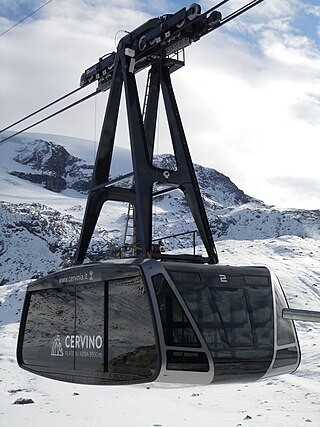
An aerial lift, also known as a cable car or ropeway, is a means of cable transport in which cabins, cars, gondolas, or open chairs are hauled above the ground by means of one or more cables. Aerial lift systems are frequently employed in a mountainous territory where roads are relatively difficult to build and use, and have seen extensive use in mining. Aerial lift systems are relatively easy to move and have been used to cross rivers and ravines. In more recent times, the cost-effectiveness and flexibility of aerial lifts have seen an increase of gondola lift being integrated into urban public transport systems.

Kemnay is a village 16 miles (26 km) west of Aberdeen in Garioch, Aberdeenshire, Scotland.
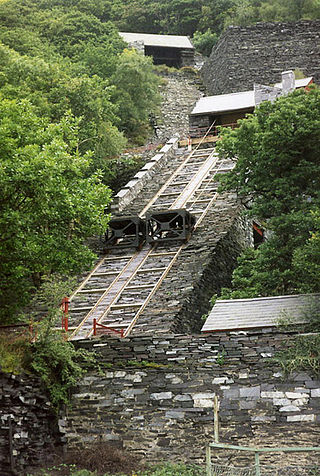
A cable railway is a railway that uses a cable, rope or chain to haul trains. It is a specific type of cable transportation.

The Penrhyn Quarry Railway was a narrow gauge railway in Caernarfonshire, Wales. It served the Penrhyn quarry near Bethesda, taking their slate produce to Port Penrhyn, near Bangor. The railway was around six miles (9.7 km) long and used a gauge of 1 ft 10+3⁄4 in.

The Padarn Railway was a narrow-gauge railway in North Wales, built to the unusual gauge of 4 ft. It carried slate seven miles (11 km) from Dinorwic Quarry to Port Dinorwic. The line opened on 3 March 1843, replacing the Dinorwic Railway. It initially used horses, but was converted to steam haulage on 23 November 1848. The railway was formally titled the Dinorwic Quarries Railway or Dinorwic Quarry Railway, but informally "Padarn Railway" was widely used.

There were more than a thousand British narrow-gauge railways ranging from large, historically significant common carriers to small, short-lived industrial railways. Many notable events in British railway history happened on narrow-gauge railways including the first use of steam locomotives, the first public railway and the first preserved railway.
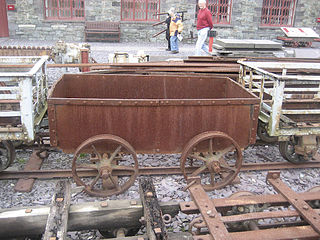
The Nantlle Railway was a Welsh narrow gauge railway. It was built to carry slate from several slate quarries across the Nantlle Valley to the harbour at Caernarfon for export by sea. The line provided a passenger service between Caernarfon and Talysarn from 1856 to 1865. It was the first public railway to be operated in North Wales.

The Rhiwbach Tramway was a Welsh industrial, 1 ft 11+1⁄2 in narrow gauge railway connecting the remote slate quarries east of Blaenau Ffestiniog with the Ffestiniog Railway. It was in use by 1862, and remained so until progressively closed between 1956 and 1976. The route included three inclines, one of which became the last operational gravity incline in the North Wales slate industry. The tramway was worked by horses and gravity for much of its existence, but a diesel locomotive was used to haul wagons on the top section between 1953 and its closure in 1961.

Llechwedd quarry is a major slate quarry in the town of Blaenau Ffestiniog, north Wales. At its peak in 1884 it produced 23,788 tons of finished slate per year and had 513 employees. It continues to produce slate on a limited scale and is the location of the Llechwedd Slate Caverns tourist attraction.

Tan-y-Manod railway station was a railway station approximately 1 mile (1.6 km) south of Blaenau Ffestiniog, in Gwynedd, North Wales.

The Eigiau Tramway might refer to the Eigiau Quarry Tramway or to the Eigiau Reservoir Tramway.

Oakeley quarry is a slate quarry in the town of Blaenau Ffestiniog, north Wales. It was the largest underground slate mine in the world, and had 26 floors spanning a vertical height of nearly 1,500 feet (460 m).

The South African Railways Class NG10 4-6-2 of 1916 was a narrow-gauge steam locomotive.

Cilgwyn quarry is a slate quarry located on the north edge of the Nantlle Vale, in North Wales. It is one of the earliest slate quarries in Great Britain, being worked as early as the 12th century. King Edward I of England was reputed to have stayed in a house roofed by Cilgwyn slates, during the Welsh wars of independence. It is one of the major slate quarries in the Nantlle Valley area.

Graig Ddu quarry is a disused slate quarry near Blaenau Ffestiniog, in Gwynedd, North Wales. Although output was only about 3,000 tons a year, it reputedly has 36 saw tables and the same number of dressing machines on site. As with others in the area, the quarry suffered from a lack of water, resulting in the siting of the mill some distance away, at a lower level.

The car gwyllt is a Welsh invention used by quarrymen to ride downhill on the steep inclined planes of a slate quarry.
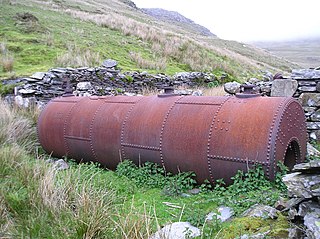
Fron-Boeth and Pant Mawr quarries were two closely related and interconnected quarries on the western slopes of Moelwyn Mawr in Gwynedd, North Wales. Pant Mawr operated from around 1850 to 1879, and was partly re-opened in 1886 when it was amalgamated with Fron-Boeth. Both quarries closed during the First World War. Finished product was transported to the slate quays of Porthmadog by the Croesor Tramway.
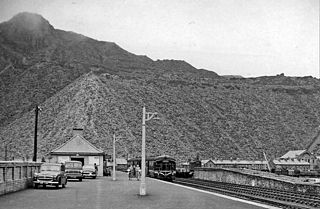
Blaenau Ffestiniog North was the London and North Western Railway's (LNWR's) second passenger station in Blaenau Ffestiniog, then in Merionethshire, now in Gwynedd, Wales.
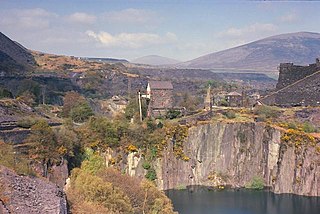
The Slate Industry in the Nantlle Valley was the major industry of the area. The Nantlle Valley is the site of oldest slate quarry in Wales at Cilgwyn, and during the nineteenth and twentieth centuries it was a major centre of the Slate industry in Wales. The quarries of the area are a World Heritage Site.
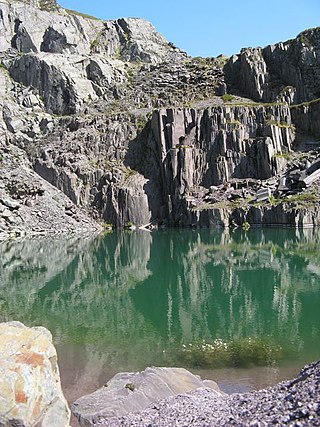
Alexandra quarry was a slate quarry in North Wales, on the slopes of Moel Tryfan in north Gwynedd. It was part of one of the major slate quarrying regions of Wales, centred on the Nantlle Valley during the 19th and 20th centuries. Output increased when a connection to the North Wales Narrow Gauge Railways branch to Bryngwyn was created. It closed in the late 1930s, but was subsequently amalgamated with the Moel Tryfan quarry, and production continued until the 1960s.